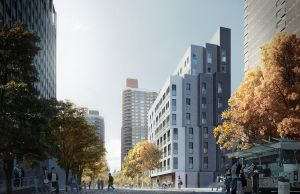
Housing Starts: Micro-Cosmopolitan Future? | Post-Sandy Flood Insurance | Bronx Co-Op Prices Up

Micro-unit development proposal for Kip’s Bay, Manhattan (Photo Credit: New York Observer)
- Micro Cosmopolitan: The Promise of Tiny Apartments in a City Where Size Is Everything The problem is that many of New York’s zoning and housing codes, written to ameliorate the kinds of slums and overcrowding that Jacob Riis documented—people living four or five to a room on the Lower East Side without plumbing or electricity—don’t speak to the current housing problems in New York City. The Lower East Side, for example, had between 600 and 2,400 people per hectare in 1910; today it has 150 to 300. ‘It was born of the progressive era and public health initiatives, although there was also a big moral component, a sense that bad housing conditions created slums, which bred crime and disease,’ said Ingrid Gould Ellen, the director of NYU’s Furman Center for Real Estate and Urban Policy. ‘And even as the city changed, the codes were not removed, but lingered.
- City Looks at Life Beyond Housing Housing activists and community-development experts have charged that Mayor Bill de Blasio’s goal to build or preserve 200,000 units of affordable housing over the next decade misses a crucial goal of improving the quality of life in some of the city’s poorest neighborhoods. Now the administration is piloting a project in Brownsville it hopes will do just that. It has overseen a new pop-up market for the Brooklyn neighborhood and plans a new playground, completed bike lanes and more prekindergarten slots.
- Hurricane Sandy Anniversary 2014: Flood Insurance To Rise For Many NYC Homeowners Acevedo is one of roughly 5.3 million policyholders in the National Flood Insurance Program (NFIP), the principal source of flood coverage for U.S. homeowners. In the time she’s been rebuilding since Sandy struck in 2012, so have policymakers grappled with an oceanic challenge: how to shore up the NFIP — which owes the Treasury Department $24 billion — without sticking homeowners with price increases. ‘The program cannot continue to be bailed out by an act of Congress every time there is a big flood,’ historian Scott Gabriel Knowles, author of ‘The Disaster Experts: Mastering Risk in Modern America,’ says. ‘It will become politically untenable.’
- Brooklyn BP Acts to Restart Two Rez Projects Earlier this month, Mr. Adams issued an advisory approval of a 51-unit residential building at 695 Grand St. in Williamsburg, most of which would be affordable. As is often the case, Mr. Adams included a list of conditions that must be met in order for him to give the project a thumbs-up. But in a twist, he also staked his approval to the revival of two completely unrelated developments that have been stalled for years—the Greenpoint Hospital site and the Broadway Triangle urban renewal area.
- Multifamily Market Sales Hit $3.2B in Third Quarter Driven by a trio of $200 million-plus deals, the city’s multifamily sector climbed to more than $3 billion worth of sales in the third quarter. The third quarter saw 213 multifamily transactions comprised of 330 buildings across the five boroughs for a total sales volume of $3.26 billion, according to Ariel Property Advisors’ quarterly market report.
- U.S. Homeownership Rate Falls to Lowest Since Early 1995 The homeownership rate in the U.S. fell to the lowest in more than 19 years as the market shifted toward renting and tight credit blocked some potential buyers. The share of Americans who own their homes was 64.4 percent in the third quarter, down from 64.7 percent in the previous three months, the Census Bureau said in a report today. The rate was at the lowest level since the first quarter of 1995.
- NYCHA Still Trying to Repair Public Housing Damaged During Hurricane Sandy Two years after Hurricane Sandy devastated public housing, dozens of storm-blasted apartments remain vacant. Most of the 172 units are in Coney Island or the Rockaways, with 58 ‘under construction,’ city Housing Authority officials said Wednesday.
- Why Middle-Class Americans Can’t Afford to Live in Liberal Cities Among the 100 largest U.S. metros, 63 percent of homes are ‘within reach’ for a middle-class family, according to Trulia. But among the 20 richest U.S. metros, just 47 percent of homes are affordable, including a national low of 14 percent in San Francisco. The firm defined ‘within reach’ as a for-sale home with a total monthly payment (including mortgage and taxes) less than 31 percent of the metro’s median household income.
- Bronx Co-Op Prices Are on the Rise but Remain the Most Affordable in City ‘I don’t know if we’re so much the ‘New Bronx’ as we are the last frontier. Harlem has been saturated, and I think that’s why we’re starting to see so much interest.’ Still, buyers say they are attracted to co-ops in The Bronx because it gives them a chance to live in a bigger home at prices that remain significantly cheaper than other parts of the city.
- $60M Sale of Bay Ridge, Midwood Portfolio Sets Record Brooklyn-based Landau Real Estate bought a four-building portfolio in Bay Ridge and Midwood for $60.3 million in an off-market deal. At $232,000 per unit, the sale marks the priciest to date in the area. The portfolio includes 465-476 84th Street in Bay Ridge, as well as Midwood-located buildings at 2566 Ocean Avenue, 1745 East 12th Street and 1811 Quentin Road. The buildings are roughly 60,000 square feet each.


